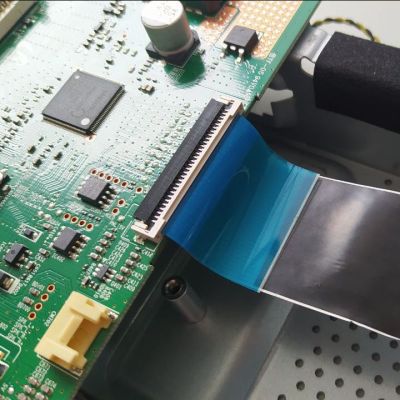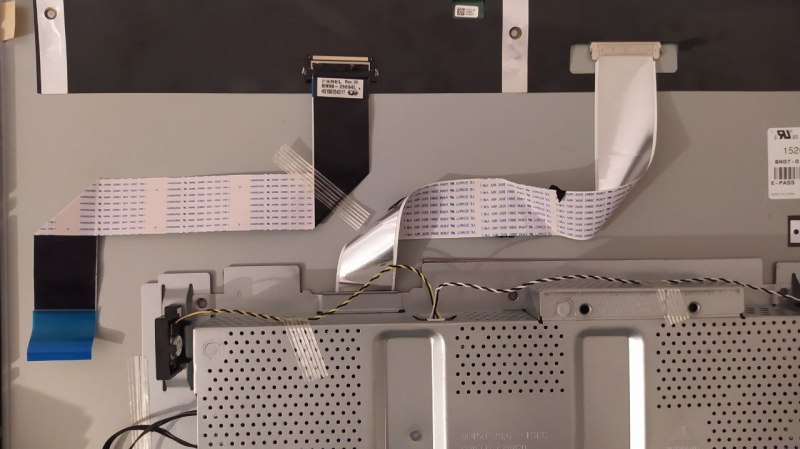
Dumpster diving is one of those experiences that can net you some pretty cool gear for a reasonable price. Case in point the 24″ Samsung S24E650XW LCD monitor that [MisterHW] saved from being trashed. Apparently in very good condition with no visible external damage, the unit even powered up without issues. It seemed like a golden find until he got onto the Windows desktop and began to notice quaint red shimmering in darker areas and other issues that made it clear why the monitor had been tossed. Of course, the second best part about dumpster diving is seeing whether you can repair such issues.
Prior to disassembly it had been noted that percussive maintenance and bending of the frame changed the symptoms, suggesting that something was a bit loose inside. After taking the back cover and shielded enclosure off, a quick visual inspection of the boards and cables quickly revealed the likely suspect: broken traces on one of the cables.
Apparently somewhere during the assembly step in the factory the cable had been pushed against the PCB’s edge, causing the initial damage. Based on the listed assembly date the monitor had only been in use for a few years before it was tossed, so likely the symptoms would have begun and worsened as one after another of the traces gradually cracked and broke due to vibrations, thermal expansion, etc.
This issue made fixing the monitor very simple, however, assuming a suitable replacement cable could be found. The broken cable is a 30P 1.0 pitch PFC, with EBay throwing up a cable with similar specs for a Thomson brand TV. One purchase and anxious wait later, the replacement cable was installed as in the featured image alongside the old cable. Perhaps unsurprisingly it restored the monitor to full working order, demonstrating once again that dumpster diving is totally worth it.
















I just wish it was easier to find places to dumpster dive.
Hard to know what places might have good stuff, accessible dumpsters, and not notice/care about you digging around.
I’d love any suggestions for sites or tricks for how to find places.
It all boils down to where you´re living, smart Anonymous …
Too many people talked about the good spots. Someone wrote books about it.
TV shows talked about it.
TV shows and web blogs suggested doing it as an income stream. i.e. “Flippers”
People were inconsiderate and made messes around the bins. People became teratorial, got into fights over the bins…
Cops sometimes had to be called.
So now the bins get padlocked fences and No Treaspassing signs all around.
Cameras put up as those got cheaper.
Pretty much the story in my city and why it might be a bit harder to find a honey-hole anywhere these days.
That said? IF you find a spot, please leave it esentialy looking like you were never there.
and Happy hunting!
Municipally sponsored electronics waste disposal depots, usually part of other waste and recycle initiatives. Of course, they can say NO, but a polite inquiry is the way to approach this. Just one example was to harvest the flat Fresnel screen on a projection TV. These huge things are flimsy, but make for good solar cooking (melting) experiments for kids.
The local recycling center used to allow me to look in their electronics bin. (Yes, I asked kindly) But the last time I was there, the man accepting the electronics firmly told me to leave as I glanced in the bin
“percussive maintenance”? Bwa ha ha 😀😁😂🤣💦
Love it!
The most expensive part of any TV/monitor is the actual display. If it okay, you can still save pretty much any screen.
You can buy generic controller boards and backlight drivers pretty easily these days, so its possible to repair any TV or display even after ripping out all electronics. You can get non-smart controller boards (usually 2 HDMI, VGA and RCA) for ~15$ with the IR receiver board and a remote, and ~20$ to 25$ for an Android one (similar IO, but it runs android, nothing special, cheap SoC + 1GB RAM + 8GB eMMC).
All you need to do is plug in the LVDS display cable from the panel to the controller board, wire up the backlight driver at the correct voltage/current and you’re good to go. Unfortunately, its also common to need an adaptor board to go between your LVDS cable and controller board because there is no standardisation for such LVDS cables, but most big brand (Samsung, Sony, etc) adaptors are plentiful.
It was quite shocking to me when I realised that TV repairmen in my town weren’t actually doing component level repair but just buying controller boards from China and swapping them out with OEM controller boards. In a way, it makes sense, why jump through the hoops to get tightly controlled components when you can instead replace the entire control board. Yes the customer might repair about the UI having changed but in the end, they’ll be able to use the TV.
People still repait TVs?
Yep. It’s a fairly lucrative activity for some people, too. Others, not so much, though. It depends on the market.
Hi there,
Would you have any examples of these generic boards at these prices? I have a few TV’s I would require these to make an economical repair. Would really appreciate the help.
I don’t know of generic board suppliers, but a web search for the TV model (include “parts” or the board number) might turn up “a pull” from a scrapper.
I can’t really say anything about the prices, they might have changed since I last looked (about 4-5 years ago when I needed to fix a family member’s TV), but it was quite inexpensive back then and I would still expect it to be inexpensive.
The proper search term to find the websites which sell these is “universal TV motherboard” or “universal TV main board”. These websites usually have everything you need to get started with TV repair. If nothing turns up, there’s always aliexpress where you can buy them.
I once repaired a dumpster LCD screen by tossing the control board 10 minutes in the toaster oven. That was enough to re-melt whatever faulty solder joint was causing the screen not to boot.
A start:
https://www.ebay.it/itm/254215053656
Thank you Peter- you have provided a very useful springboard. I have many with TV tuner functionality/sound issues and hopefully this will lead to them being saved from landfill.
I’ve yet to try one out, never bothered picking up large screens discarded by the bins but now there’s an incentive. Since the local council here in Italy started requiring everyone to register there name, fiscal number, and what is being discarded at the community dump, people have started to simply leave appliances next to the bins at night. Occasionally some goodies ! The local dump doesn’t allow anyone to retrieve discarded items. Kind of hypocritical while everyone is going on about the environment yet they block you from repairing and reusing.
“Kind of hypocritical”
Agree!
Sadly our twice a year long traffic snakes around the county fairgrounds for drop off. Keep moving don’t even have to get out of the car. Don’t get out of your car period. Lust not, but by that trip a big screen is cracked by now. The way they are stacked, all done! But seeing vintage stereo components, sigh.
I like to find TV’s cracked but usable for the best work light ever till direct emitter screens take over. I got a giant solar lens without spread optics from a big box TV.
This is all about lawyers and liability insurance at those worksites. CYA. Some part out some things but most hurry to palletise it all.
The alternative is up to us, posting in a community site like Craigslist for free or at some local reusing effort.
Aliexpress sells those ribbon cables in virtually every pitch and length you might want, and for pennies for ten of them. It’s really handy when you realise how few insertions they are rated for.
I believe it should say FPC (Flexible Printed Cable) or FFC (Flat Flexible Cable), not PFC (Power Factor Correction).
I found a spot behind a TV/appliance electronics store…customers buy something new and the old stuff gets put out behind for anyone to drive up and snag. Lucky one day to find a pristine Sony 55 inch x900e. 4 blinking red lights. Months later and tonnes of research and trial and error…got rid of the 4 red blinks by soldering a thin wire from one board to another, basically saying the LEDs were still good (though, ended up replacing all of them). Still, no picture at all…TV would automatically go into a test pattern….
Anyway, I read one post on Badcaps…the guy took a razor blade and cut a millimeter off the end of one of the LVDS cables….seemed to good to be true, but it was the last thing I tried…and it totally worked!! (and I could not believe how much Sony replacement parts cost. )